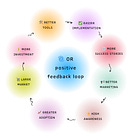📈 #65 Optimization as a competitive advantage: aligning mathematical models with business KPIs
How to systematically connect OR projects to KPIs through the IMPACT framework
Today’s post is sponsored by…
Advanced analytics for smart decisions.
👉 Do you want to sponsor a post in Feasible? Just reply to this email.
I apologize for not sending you this article last week.
The flu hit home and it was chaotic for days, so I couldn’t spend a minute on my laptop to write it. And I just got confirmed my sponsor!
I have to thank DECIDE for being supportive and waiting for a recovery. 🙏🏻
That being said...
I started working in optimization to find efficient algorithms that obtain (near) optimal solutions quickly.
It was about computational efficiency, understanding algorithms deeply, and creativity to solve problems.
I loved it.
In the industry, you face a different situation: stakeholders don’t care about those technicalities. They can be a barrier to using your optimization engine. They may not even use your solutions.
The best model is useless if it doesn't impact business outcomes.
Today, I want to discuss the impact of your OR project on businesses at Feasible:
📊 Understanding business impact through 3 examples
⚙️ IMPACT, a framework to connect business KPIs to OR projects
✅ Best practices to advance to the next level
Companies turn mathematical models into business outcomes using optimization as a strategic tool.
→ DECIDE developed all 3 use cases here.
🎧 At the top, you can listen to a podcast-like version of this post!
Ready? Let’s dive in… 🪂
📊 Understanding business impact
Key Performance Indicators (KPIs) are quantifiable measures for evaluating organizational performance and monitoring progress toward strategic objectives.
Optimization is a powerful tool for achieving these KPIs through efficient resource allocation and enhanced operational performance.
Optimization influences KPIs across key areas like cost reduction, operational efficiency, and customer satisfaction.
Let’s examine them through specific examples.
💰 Banking optimization
Many banks worldwide need to sell their products to current or potential customers.
They need to send their commercial teams to persuade people to get loans, buy new financial products, or offer additional services like insurance or premium products.
How does the commercial team know what to do and when?
A Spanish bank was doing this during weekends: some employees prioritized which tasks to perform the next week, assigning them to the commercial team.
They knew they could do better, so they implemented advanced analytics to automate operations instead of letting those people handle the responsibilities on weekends. They reduced the manual planning time from several days to a few hours and improved the commercial team’s productivity.
It’s a win-win-win: the bank increases ROI on campaigns, manual planners spend less time on manual work, and the commercial team is more satisfied because they are more efficient.
🛡️ Intelligent security planning
The problem becomes complex with tens of thousands of employees worldwide, varying country laws, and the need to adjust shifts and resources considering skills.
It’s a multinational security company operating in Spain, France, Portugal, Argentina, Chile, Uruguay, and Perú.
They managed their surveillance services manually. The planning staff had to adjust shifts, resulting in downtime, overstaffing, and compliance challenges.
Lots of inefficiencies and high operational costs.
They decided to integrate an automated planning system based on mathematical optimization to optimize shift and resource allocation. This system automatically adjusts schedules to meet demand and identifies the most suitable employees to fill vacancies, respecting all legal and contractual constraints.
The results? They improved employee-task assignment based on skills, eliminated downtime, and created fairer working calendars to prevent overwork on weekends and public holidays.
Again, a win-win-win: the company reduced operational costs by up to 5%, employees are happier with better tasks and reduced overtime, and customer satisfaction improved.
🚇 Resource allocation in public transport
Metro companies in big cities have many employees.
Like thousands of workers.
They have their own systems to decide the starting and ending locations for each employee or their shifts, considering tenure with the company.
A Metro company in a major Spanish city manually and rigidly did staff planning, taking over 5 hours to adjust schedules and adapt to demand changes or collective agreement restrictions.
This method limited operational flexibility, increased error risk, and created tensions in personnel management.
After implementing a resource allocation system based on mathematical optimization, a team fully automated schedule planning. This allowed for quick adaptation to new regulations or operational changes.
The tool simulated demand changes to see the impact of different assignments. This improved strategic decision-making, allowed more informed decisions, and enhanced overall service efficiency.
This third use case is a win-win-win: the Metro company makes better decisions faster, employees reduce their tensions, and passenger satisfaction increases due to service efficiency.
Optimization can drive significant business value across industries. The challenge lies in consistently delivering this value and ensuring projects align with key business metrics.
Having a structured framework is essential.
I present the IMPACT approach to connect optimization initiatives to business outcomes.
⚙️ IMPACT, a framework to connect business KPIs to OR projects
It happens.
Despite the success of some projects you read, too many OR projects fail. They fail not because the models are wrong, but because they don’t deliver significant business impact.
Brilliant optimization models go unused, stakeholders don’t see the value, and their results don’t translate into business outcomes. What’s an OR project without value?
How do we ensure our OR solutions create an impact?
I follow a framework to maintain consistency in the project.
This framework is a series of steps to build a strong relationship between you and the business. It ensures the OR project aligns with business KPIs and delivers tangible outcomes.
It’s called IMPACT:
1️⃣ Identify KPIs
First, work with stakeholders to understand the key metrics that measure business success.
Business success can mean many things, from reducing costs to ensuring customer satisfaction.
If you have a quantitative metric like a KPI, it’s easy to compare previous values with the new ones from the OR project.
2️⃣ Map KPIs to project objectives
The second step is framing the OR problem to enhance one or more KPIs.
The KPI might be reducing transportation costs, so the project objective could be optimizing vehicle routes for cost minimization.
3️⃣ Prioritize based on business impact
The third step ranks KPIs by their significance to the organization’s strategy. What is more important, cost reduction or customer satisfaction?
Focus on objectives that influence top-priority KPIs and balance the difficulty of achieving them.
Maybe the top-priority KPI is so difficult to achieve that it’s better to address others to start contributing value to the business soon.
4️⃣ Align model metrics with KPIs
In this fourth step, connect model-specific metrics to business KPIs.
Ensure the objectives in your objective function relate to the defined KPIs.
I remember having trouble connecting our objectives like reducing empty km and driver waiting time.
To minimize empty km, you tell drivers to wait indefinitely for a nearby load. Obviously, they complain since they want to drive to earn money.
We could reduce everything to money (cost of empty km and waiting?) so planning could be more cost-efficient.
5️⃣ Communicate impact effectively
The fifth step is communication. Use terminology stakeholders understand since you are talking to them.
Instead of saying “this solution has a 1% gap” -please don’t say this at work-, say “this solution led to a 10% cost reduction from 100k€/month to 90k€/month.”
6️⃣ Track KPI evolution after deployment
The sixth and last step is to track the evolution of those KPIs after deploying your solution.
Deployment is good, but don’t stop there.
Validate that your solution consistently delivers business value. Track project KPI values to demonstrate your project enhances the business.
The core idea is to keep this framework focused on understanding the business context, translating it into optimization objectives, designing models, and showcasing the results.
This structured approach builds a strong relationship with stakeholders, ensures the OR project aligns with their needs, and delivers measurable outcomes that create impact.
✅ Best practices to get to the next level
I needed time to improve this framework.
I realized some points provide more value. For instance, steps 1 (identify KPIs) and 5 (communicate) influence your relationship with stakeholders.
Your KPI definitions will influence the project’s success measurement.
Here are 3 practices that work for me:
🤝 Collaborate early and often with stakeholders
Frequently and from the beginning, engage stakeholders in your project.
This gives you more control over what’s important for them, and they’ll have greater trust in your process.
You’ll have more accurate KPIs sooner in the project.
🎯 KPIs should be SMART
Yes, another acronym. But that’s not mine!
SMART stands for Specific, Measurable, Achievable, Relevant, and Time-bound.
Why not define a KPI as “Reduce average delivery time from 3.5 days to 3 days within 6 months” instead of “Improve delivery speed”?
Do you see the difference? Which one aligns better with your understanding of the stakeholder’s problem?
📊 Use visualizations whenever possible
In addition to avoiding overly technical language in results, I suggest adding visuals.
For a planning problem, use a Gantt chart instead of a text file.
If you’re solving a vehicle routing problem, build an interactive map to show the routes of each vehicle instead of stating the locations for each vehicle.
If you are optimizing inventory levels, don’t just show a stock levels table. Use a heatmap or time-series graph to highlight trends and fluctuations over time.
🏁 Conclusions
Organizations must choose whether to treat optimization as a technical function or leverage it as a strategic driver of business performance.
Those who align optimization with KPIs consistently outperform their peers, achieving:
🏆 Sustainable competitive advantages
⚙️ Enhanced operational excellence
📈 Superior financial performance
⚡ Greater market agility
When KPIs guide optimization, the results are clear. Optimization isn’t about numbers; it’s about business impact.
The future belongs to organizations that can systematically connect optimization initiatives to business outcomes. This will create a cycle of continuous improvement and market leadership.
Let’s keep optimizing,
Borja.
DECIDE transforms advanced analytics into intelligent decisions and tangible results.
At DECIDE, they combine Intelligent Automation, Artificial Intelligence, and Mathematical Optimization to help businesses maximize efficiency and competitiveness.
Agility and precision: Implementing predictive analytics and machine learning solutions with seamless integration tailored to each business.
Optimized decision-making: Reducing uncertainty with advanced models that enhance planning, optimization, and operational management.
Innovation with impact: Turning technology into real value through scalable infrastructures, automated processes, and data-driven strategies.
DECIDE leads the change in sectors such as logistics, banking, insurance, energy, telecommunications, and healthcare, with proven solutions that deliver immediate impact.
Explore the future of decision-making: Check out their latest publications, the Strategic Guide to Supply Chain 2025 and the Strategic Guide to Energy 2025, featuring use cases, industry trends, and expert insights.
DECIDE is Advanced analytics for smart decisions.










